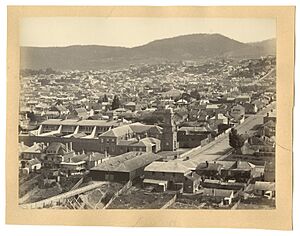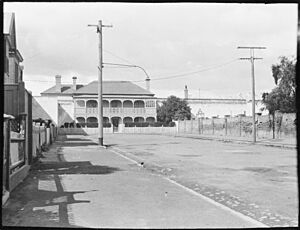Campbell Street Gaol facts for kids

Part of the remains of the Campbell Street Gaol
|
|
| Location | Hobart, Tasmania |
|---|---|
| Coordinates | 42°52′39″S 147°19′37″E / 42.8774°S 147.3270°E |
| Status | Historic site |
| Security class | Maximum (males and females) |
| Capacity | 1,200 |
| Opened | 1821 |
| Closed | November 1960 (males) 1963 (females) |
| Managed by | National Trust of Australia (as 'The Tench' – Penitentiary Chapel Historic Site) |
The H.M. Gaol Hobart, also known as Campbell Street Gaol, was a very old prison in Hobart, Tasmania, Australia. It held both men and women who had committed crimes. Convicts built this prison, and it was open from 1821 until the early 1960s.
In 1961, the male prisoners moved to a new facility called H.M. Risdon Prison. The female prisoners moved to the Risdon Women's Prison in 1963.
The famous architect John Lee Archer designed parts of the jail in a style called Georgian Renaissance. Today, what is left of the old jail is looked after by the National Trust of Australia (Tasmania). It is now a special historic site that people can visit.
Contents
A Look Back: The Old Hobart Prison's Story
The first part of the jail was built by convicts in 1821. It was first called the Hobart Town Prisoner's Barracks. It could hold about 640 men. However, many thousands of convicts arrived in Tasmania each year. This meant the barracks quickly became too small.
How the Prison Grew Over Time
Over the next ten years, the prison was made bigger in many steps. It eventually held over 1,200 men. They used every bit of space, even the areas above the ceilings! From 1846, it started to be used as a regular prison for civilians.
After convict transportation stopped in 1853, it became Hobart's main prison. It was then known as the Hobart Town Gaol. It replaced an older, unsafe prison on Murray Street. A new cell-block was built to the north of the original one. The jail stayed mostly in this form until it closed.
The Prison's Closure and What Remains
By the late 1940s, the jail was considered too old and too small. So, plans were made to move prisoners to a new facility. The move to the new Risdon Prison began on November 25, 1960.
The Campbell Street Gaol officially closed in 1963. Most of its buildings were torn down, except for the courtrooms. These courtrooms were used until 1983. Then, new court buildings were opened in Salamanca Place.
The old court buildings on Campbell Street were saved. They are now cared for by the National Trust and are open to the public. Only small parts of the outer wall of the former jail can still be seen today along Campbell Street.
Punishments and Conditions Inside
The Campbell Street Gaol was one of three prisons in Tasmania where serious punishments, including executions, took place. A total of 32 people were executed there between 1857 and 1946. The last execution in Tasmania happened at this jail. You can see the scaffold, which was used for these punishments, as part of the guided tours today.
The cells in the jail never had toilets. Instead, prisoners used simple buckets.
Modernizing the Old Prison: Efforts and Changes
In the first half of the 1900s, people looked into the Campbell Street Gaol six different times. All these investigations agreed that the prison desperately needed to be updated and improved.
Early Attempts to Improve Conditions
In 1916, a special committee looked at whether the jail needed major changes. They suggested building a completely new jail instead. However, only a smaller amount of money was given to make temporary fixes. These changes aimed to address the worst problems.
Prisoners were moved to the northern wing, and the older southern section was used for office work. In 1916, improvements included connecting the jail (but not the cells) to the sewerage system. Gas lighting was also changed to electricity. However, the kitchen and workshops still used wood-fired ovens and boilers.
Some cells were very small and did not have enough light. The prison Governor at the time was happy with the changes. Two small cells were combined into one new, larger cell. This made it more humane for prisoners who had to stay in their cells over weekends and holidays.
Plans for a New Prison and Farm
In 1935, another official inquiry looked into problems with the prison system. Sadly, the report from this inquiry was lost. Later that same year, another committee recommended replacing the jail with a modern facility. They wanted to get rid of the terrible conditions at Campbell Street.
One idea was to move the jail to the countryside, but not too far away. This new prison would have a farm where less dangerous prisoners could work. This would also help the prison grow its own food and produce. In 1937, a property was chosen at Hayes, which became the Hayes Prison Farm. However, the idea of moving all prison operations to Hayes was later dropped.
The Road to Risdon Prison
After more escapes from Campbell Street Gaol, another inquiry happened in 1943. This led to the government buying a large piece of land in 1949. This land was about 90 acres on the eastern side of the Derwent River. It was near Risdon Cove, where Europeans first settled in Tasmania.
The 1943 inquiry also heard that the southern part of Campbell Street Gaol was still used for cells. This included four dark cells for solitary confinement. It took ten more years, but the new Risdon Prison finally opened in 1960.
Famous People Held at the Jail
Many people were held at the Campbell Street Gaol. One notable person was Margaret Coghlin, who was the last woman executed in Tasmania.
The famous bushranger Martin Cash was also briefly held there after he was caught nearby. Cash was trying to escape from the Old Commodore Inn. He ran down Argyle Street and turned into Melville Street, hoping to reach the Domain. But the street was a dead end, blocked by the jail and the Prison Governor's house. A gunfight happened, and Cash was captured. For a long time, this part of Melville Street was known as 'Martin's Mistake' because of his failed escape.
What You Can See Today
Parts of the jail and its buildings were designed by John Lee Archer. He was an Irish engineer and architect who worked in Van Diemen's Land (Tasmania) from 1827 to 1838.
Today, only a few buildings remain at the corner of Campbell and Brisbane Streets. You can also see the bottom part of a tall sandstone wall that once surrounded the jail on the Campbell Street side.
The remaining complex includes a church, built between 1831 and 1833. This church was built over solitary confinement cells. In the late 1850s, it was changed into a prison chapel and law courts. Today, this area is called the Penitentiary Chapel Historic Site.
The scaffold, which was used for executions, was fixed up in the 1980s. It still uses the original parts.




